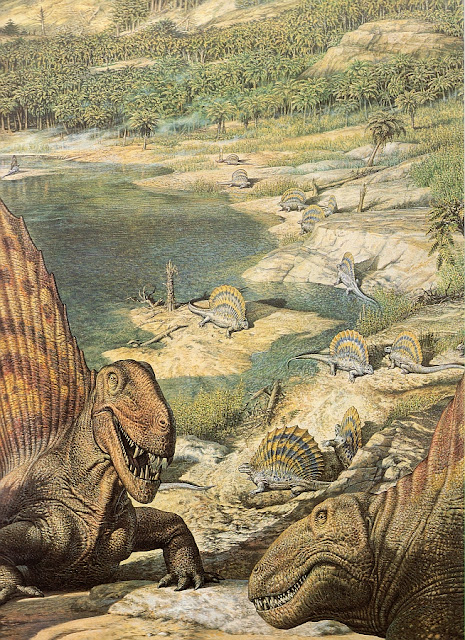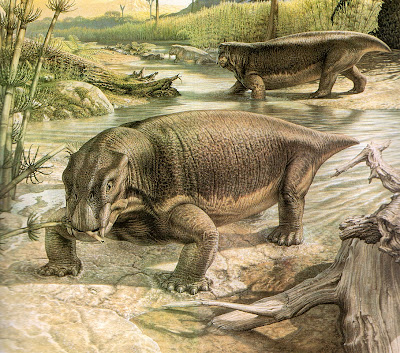In common with so many popular dinosaur books, and in spite of its title, De Oerwereld van de Dinosauriërs (aka Dinosaurs: a Global View) actually dedicates quite a number of pages - and indeed plates - to animals from the Palaeozoic that preceded the first dinosaurs by tens of millions of years. In fact, the book even gives over a great deal of room to synapsids. Not that I'm complaining, of course, as it means we get to enjoy even more stunning works of art than we would otherwise have done...like this one. (It's also a good excuse to keep the 'Vintage Dinosaur Art' title for this post, see.)
Dimetrodon is probably the most well-known Palaeozoic creature in popular culture, and is known to anachronistically frequent dinosaur movies, toy ranges and the like (and even appears in silhouette form on the wall of the Natural History Museum's 'Dino Store'. Oh yes, I noticed. Cheeky Dimetrodon). John Sibbick's depiction of the beast is perhaps my favourite piece of his that appears in this book. The foreground stars are stunning, of course, and the three-quarter view is perfect for emphasising the animal's deep, narrow skull, its sprawling posture and a general appearance that seems confusing and contradictory at first; it's no wonder that the term 'mammal-like reptile' has tended to stick.
That said, it's the wonderful backdrop here that really made me fall in love with the Permian all over again. The glorious vista, populated by a herd of the pin-headed sailback Edaphosaurus, effectively draws the viewer's gaze slowly inward, immersing them completely in this subtly alien world. And the water looks lovely.
Given its aforementioned popularity, it shouldn't be too surprising that Dimetrodon makes another appearance in this Doug Henderson piece. However, whereas Dimetrodon is typically shown hauling itself across the sun-parched earth, here Henderson depicts it taking to the water in pursuit of its prey - and why not? Partially concealed beneath the surface, the Dimetrodon here takes on a startling, bizarre silhouette - a jutting, knife-like fin trailing a vicious set of gaping jaws. It's easy to imagine Dimetrodon going for a dip fairly frequently, given the rich pickings offered in the form of amphibians like these Diadectes.
It's the lesser-known Early Permian gang! On the left, anyway. Dimetrodon might get all the glory, but this little lot are the unsung heroes of the period (indulgent in-joke, sorry). The style is unmistakably Sibbick, right down to the last preposterously miniscule warty detail on the adorable Cacops (foreground). This scene also features the ludicrously shrunken-headed synapsid Casea and, in the far background, the fearsome Varanops which, in spite of appearances, was also a synapsid. The forked tongue would appear to be Sibbick taking the monitor lizard analogy a little too far.
On the right, well, I've cheated; this mandible-disarticulating Doug Henderson piece actually depicts a still earlier world - that of the Late Carboniferous, over 310 million years ago. This piece is a spectacular summary of the age as one dominated by enormous, bizarre-looking plants, with Sigillaria looming imposingly from behind a tangled veil of tree ferns. The dramatically leaping animal in the foreground is Hylonomus, the earliest known definitive reptile. While I realise I gush about Henderson non-stop, this truly is one of his masterpieces; I only wish I had an enormous print of it to hang on my wall.
Moving on up to the Triassic, and Henderson provides us with one of the more memorable restorations of Postosuchus to feature in a popular book. Here, the sinister archosaurian macropredator adopts a nonchalant air as it tosses a young Desmatosuchus to the skies, perhaps with the aim of breaking off a few of those unpalatable spines. Yet another example of Henderson's superb and original compositions - a brilliant imagination to match his artistic flair. Gush gush gush. I hear his feet really smell*, though, which is important to take into consideration. Just remember that.
Lystrosaurus is perhaps best known for being a dumpy, herbivorous creature that nevertheless came to be the UNQUESTIONED MASTER OF THE EARTH...for a while, following the worst-ever mass extinction at the end of the Permian, an event so catastrophic that ITV's Saturday night schedule pales by comparison. (Sadly, no one has yet seen fit to make a film entitled 'When Lystrosaurus Ruled the Earth', in which herds of dopey dicynodonts slowly mill around a vast arid landscape in real time for three hours, set to an ever-so-arty minimalist soundtrack.)
Anyway, the top illustration, by Sibbick, makes for a charming profile of the creature with a typically lovely, peaceful ambience. The lower illustration, by Mark Hallett (he's back!), is a detail from a larger piece in which an unfortunate individual is being reduced to raw hamburger by a ravenous gang of Cynognathus. I can only apologise, again, for not being able to reproduce more of it here - however, this detail does show Hallett's remarkable, seemingly intuitive grasp of what makes a painted animal appear truly alive.
And finally...some ichthyosaurs. But wait, stifle your yawns at the back, for these are giant ichthyosaurs - Shonisaurus! The rather rotund restoration of the animal dates this picture a little now, but it remains astonishingly beautiful; the oceanic murk is realistic enough to be eerie, and the dappled sunlight on the backs of the animals is fantastically well observed.
All this without mentioning any peculiar ideas on the origin of birds...we may have to return...
*Not at all true.









Don't despair - you actually can have a giant print of Hylonomus on your wall, signed by the artist: http://www.ebay.com/itm/Carboniferous-Nova-Scotia-Hylonomus-/330609553746
ReplyDeleteThe international postage rates are stonking (not Henderson's fault). But I will own one. In the next few months. I MUST own one...
Delete"raw hamburger"
ReplyDeleteI thought that horses evolved in the cenozoic?
Ba-doom-tish.
Delete"its sprawling posture and a general appearance that seems confusing and contradictory at first;"
ReplyDeleteHow so? Just wondering.
"The lower illustration, by Mark Hallett (he's back!), is a detail from a larger piece in which an unfortunate individual is being reduced to raw hamburger by a ravenous gang of Cynognathus."
Is there any evidence for social/pack-hunting Cynognathus or is it just a paleoart meme? The oldest reference I could find to it was a Knight painting, so I wouldn't be surprised if it's the latter, but I wanted to make sure.
Oh, the more basal synapsids just continue to look strange to me, in spite of the fact that I'm aware of their evolutionary context. In particular, it's that mammalian-looking head perched on a rather reptilian-looking body. Of course, appearances are deceiving.
DeleteAs for Cynognathus, I really don't know. Maybe someone else can help...?
The Mark Hallett painting of the Cynognathus pack feeding is one of my favorite paleoart pieces of all time. Very wolflike, yet very alien; a bit disturbing, yet very convincing.
ReplyDelete(No, I don't know if there is any evidence for pack hunting in Cynognathus. I doubt that there is.)
Sadly, no one has yet seen fit to make a film entitled 'When Lystrosaurus Ruled the Earth', in which herds of dopey dicynodonts slowly mill around a vast arid landscape in real time for three hours, set to an ever-so-arty minimalist soundtrack.
ReplyDeleteI would watch that film. Just add a Philip Glass soundtrack and we're gold.
Almost forgot: If you haven't already, I recommend reviewing Hallett's "The Puzzle of the Dinosaur-Bird: The Story of Archaeopteryx" for several future paleoart posts.
ReplyDelete